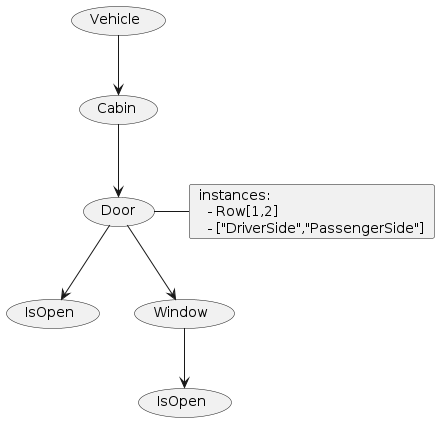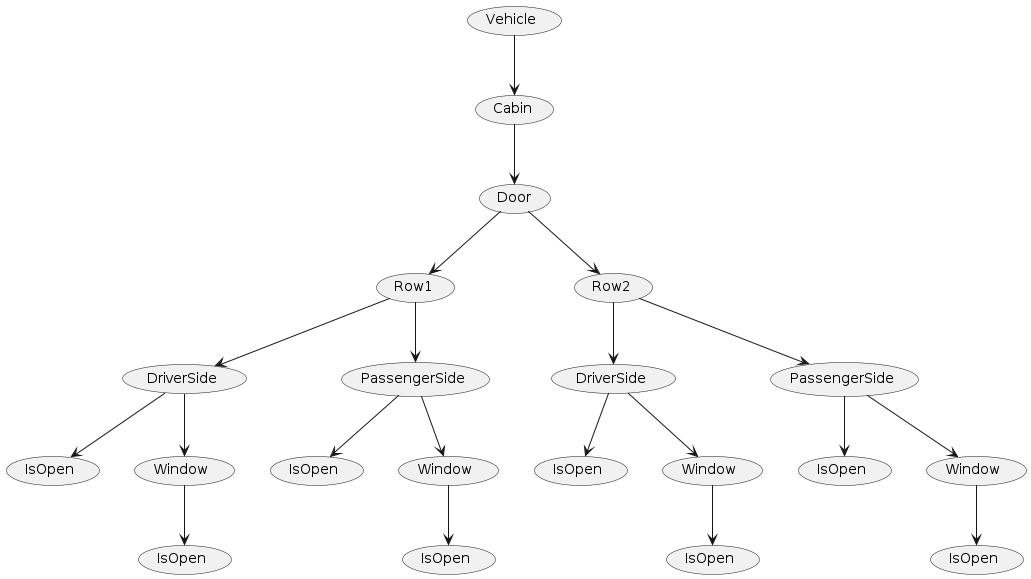Instances
VSS resembles primarily the physical structure of the vehicle, so quite often there is a need to repeat branches and data entries (e.g. doors, axles, etc). To avoid hard-coded repetitions of branches and data entries in the specification an instance-concept is supported. Instances remove the need of repeating definitions, by defining at the node itself how often it occurs in the resulting tree. They are meant as a short-cut in the specification and interpreted by the tools. As an example is shown below for doors:
When expanded this corresponds to:
Definition
How can I create instances for my branch?
- An instance can be defined in any branch.
- The instantiation is done for every node in the following path.
- Instances are defined with the key-word
instances, followed by its definition, which can be either:- a list of strings, where each element defines a single instance, e.g.
['DriverSide','PassengerSide']results into two instances of every following data entry in the path, namedDriverSideandPassengerSide - a string, followed by a range defined through
[n,m], withn,mas integer andn <= m, which defines the number of instances.Position[1,4]results into 4 instances of every following data entry in the path, namedPosition1,Position2,Position3andPosition4.
- a list of strings, where each element defines a single instance, e.g.
- If multiple instances occur in one node or on the path to a data entry, the instances get combined, by the order of occurrence. Following the example above, four position instances will be created for each of the ‘DriverSide’ and ‘PasengerSide’ instances, resulting into a total number of 8 instances.
Use of instances in VSS Standard Catalog
The VSS standard catalog is configured to represent a typical passenger vehicle, with two axles and two rows of seats. For other vehicles, see recommendations on instance mismatch below.
Typical naming conventions used in VSS standard catalog include:
- When instances are defined by a range, e.g.,
Position[m,n], VSS standard catalog uses1as start index for the first instance. - The instance definition
Row[n,m], e.g.,Row[1,2], is used to indicate that there are multiple rows of the entity. Rows are counted from the front of the vehicle. - For items located on either left or right side of the vehicle VSS standard catalog uses two different conventions:
- In some cases instances are defined relative to driver position, e.g.,
["DriverSide", "PassengerSide"]. - In other cases instances are defined based on physical position, e.g.,
["Left","Right"].
- In some cases instances are defined relative to driver position, e.g.,
How can I exclude child-nodes from instantiation?
Often it makes sense to instantiate all child-nodes of a branch. But there could be cases, when nodes are linked more the general concept of a branch, but not to the single instance.
To exclude a child-node from the instantiation of the direct parent node, set the
keyword instantiate to false (true by default). Please check the following
example for details.
Example
The example from above in the specification:
# Cabin.vspec
Door:
type: branch
instances:
- Row[1,2]
- ["DriverSide","PassengerSide"]
description: All doors, including windows and switches
#include SingleDoor.vspec Door
Door.SomeSignal:
datatype: uint8
type: attribute
instantiate: false
description: A door signal that should not be instantiated.# SingleDoor.vspec
#
# Definition of a single door
#
IsOpen:
datatype: boolean
type: actuator
description: Is door open or closedResults in the following signals:
Vehicle.Cabin.Door.SomeSignal
Vehicle.Cabin.Door.Row1.DriverSide.IsOpen
Vehicle.Cabin.Door.Row1.PassengerSide.IsOpen
Vehicle.Cabin.Door.Row2.DriverSide.IsOpen
Vehicle.Cabin.Door.Row2.PassengerSide.IsOpenRedefinition
It is possible to override the default instantiation provided by VSS by redefining the branch with different instantiation information. If multiple definitions of a branch exist with different instance definitions, then the last found definition will be used. As an example, if three row of doors are needed, then the default VSS instance definition can be overridden by redefining the Door branch as shown in the example below.
#Redefinition changing number of rows from 2 to 3
#The redefinition must appear "after" the original definition
Vehicle.Cabin.Door:
type: branch
instances:
- Row[1,3]
- ["DriverSide","PassengerSide"]
description: All doors, including windows and switchesRecommendations
VSS standard catalog is designed to cover a wide range of vehicles.
This means that the default instantiation used in VSS may not fit every vehicle.
An example can be seen in the windshield signals defined in Body.vspec, parts of them are shown below.
VSS offers the possibility to control windshield heating separately for front and rear windshield,
and VSS also gives the possibility to report washer fluid level separately for each windshield.
This fits very well for a vehicle that has separate washer fluid containers for front and rear windshield
and that offers heating for both windshields. But that is not the case for all vehicles,
it is not even certain that all vehicles have two windshields. This sections gives recommendations on how
to use VSS for a vehicle if the VSS specification does not offer an exact match of the capabilities of the vehicle.
Windshield:
type: branch
instances: ["Front", "Rear"]
description: Windshield signals
Windshield.Heating:
type: branch
description: Windshield heater signals
Windshield.Heating.Status:
datatype: boolean
type: actuator
description: Windshield heater status. 0 - off, 1 - on
Windshield.WasherFluid:
type: branch
description: Windshield washer fluid signals
Windshield.WasherFluid.LevelLow:
datatype: boolean
type: sensor
description: Low level indication for washer fluid. True = Level Low. False = Level OK.Recommendation: Instance Mismatch
If a vehicle does not have as many instances as specified in VSS then one of the following methods are recommended:
- Redefine the branch. If a vehicle for example does not have a rear windshield then change instance definition in an overlay :
Vehicle.Body.Windshield:
type: branch
instances: ["Front"]
description: Windshield signals- Accept that a
branch Vehicle.Body.Windshield.Rearwill exist in the generated VSS representation. Use mechanisms outside VSS to ignore that branch.
Recommendation: Features shared among instances
If a feature is shared among instances, it is recommended to publish that feature for all concerned instances.
Example: In VSS washer fluid can be handled separately for front and rear windshield.
If a vehicle use a common container serving both front and rear windshield,
then it is recommended that the vehicle report information on that container in both
Vehicle.Body.Windshield.Front.WasherFluid.LevelLow and Vehicle.Body.Windshield.Rear.WasherFluid.LevelLow.
Recommendation: Features lacking for some instances
Not all instances in a vehicle might have the same features. If e.g. the front windshield
from the example above lack a heater, then it is recommended to use mechanisms outside VSS
to ignore Vehicle.Body.Windshield.Front.Heating.

